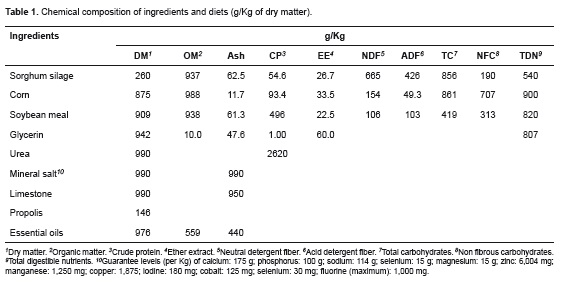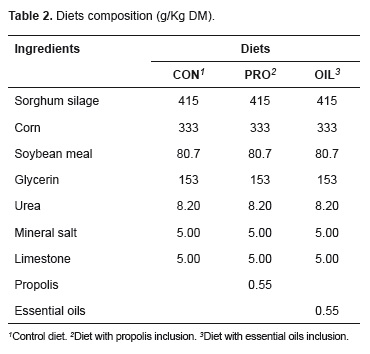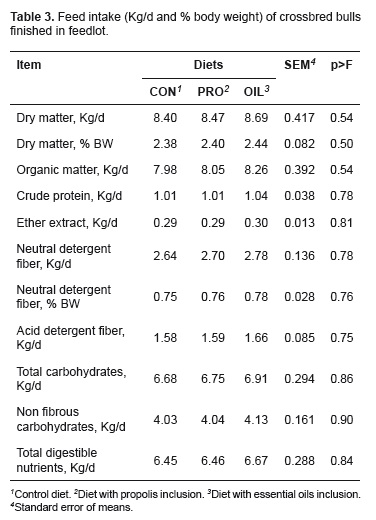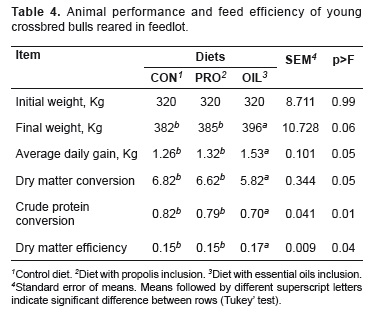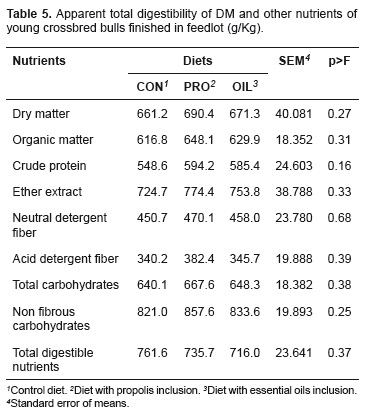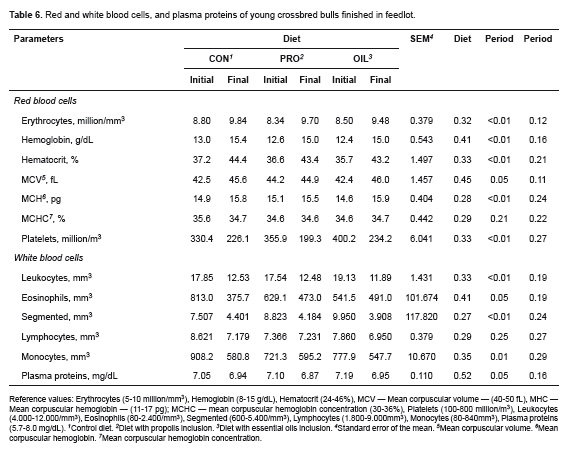Services on Demand
Journal
Article
Indicators
-
 Cited by SciELO
Cited by SciELO -
 Access statistics
Access statistics
Related links
-
 Cited by Google
Cited by Google -
 Similars in
SciELO
Similars in
SciELO -
 Similars in Google
Similars in Google
Share
Revista Colombiana de Ciencias Pecuarias
Print version ISSN 0120-0690
Rev Colom Cienc Pecua vol.29 no.1 Medellín Jan./Mar. 2016
https://doi.org/10.17533/udea.rccp.v29n1a04
ORIGINAL ARTICLE
doi: 10.17533/udea.rccp.v29n1a04
Feeding propolis or essential oils (cashew and castor) to bulls: performance, digestibility, and blood cell counts¤
Alimentación de toros con propóleos o aceites esenciales (anacardo y ricino): desempeño, digestibilidad y conteo de células sanguíneas
Alimentação de touros com própolis ou óleos essenciais (caju e mamona): desempenho, digestibilidade e contagem de células sanguíneas
Maribel V Valero1, MV, Zoot, PhD; Mariana S Farias1, Zoot; Fernando Zawadzki2, MV, PhD; Rodolpho M Prado1, Zoot; Carlos A Fugita1, Zoot, PhD; Dayane C Rivaroli1, Zoot; Mariana G Ornaghi1, Zoot; Ivanor N Prado3*, Zoot, PhD.
1Department of Animal Science, Universidade Estadual de Maringá, Science grant, CNPq fellowship, Brazil.
2Department of Animal Science, Universidade Estadual de Maringá, CAPES fellowship, Brazil.
3Department of Animal Science, Universidade Estadual de Maringá, CNPq IA fellowship, Brazil.
*Corresponding author: Ivanor N Prado. Universidade Estadual de Maringá, Department of Animal Science, Avenida Colombo, 5790, CEP: 87.020-900. Maringá, Paraná, Brazil. E-mail: inprado@uem.br
Received: October 2, 2014; accepted: September 29, 2015
Summary
Background: in cattle production systems, antibiotics are commonly fed to cattle to prevent diseases, metabolic disorders, and to improve feed efficiency. Considerable effort has been devoted towards developing alternatives to the use of antibiotics. Objective: to evaluate the effect of propolis or cashew and castor oils on animal performance, feed intake, digestibility, and blood cell counts of young bulls. Methods: bulls were kept in a feedlot for 49 days. Starting on the 40th day, feces were sampled for five days to estimate digestibility using indigestible dry matter (DM) as a marker. Bulls were fed a control diet (CON) with sorghum silage (41% DM) and cracked corn, soybean meal, glycerine, limestone, and mineral salt. The propolis-supplemented group (PRO) received 3 g/animal/d in the concentrate. The essential oils-supplemented group (OIL) received 3 g/animal/d (1.5 g cashew oil + 1.5 g castor oil) added to the concentrate. Results: final body weight, average daily gain and feed efficiency were better for bulls fed the OIL diet. Propolis or essential oils had no effect on feed intake and digestibility. There was no effect of propolis or essential oils on blood cell counts. Red blood cell concentration was greater in the last day of the experiment, while the number of white blood cells was lower. Conclusions: dietary addition of propolis did not affect bull performance or feed efficiency. The addition of essential oils improved performance. Feed intake, digestibility, and blood cell counts were similar in all treatments.
Keywords: antioxidants, biodiesel, cattle, co-products, feedlot, plant oils.
Resumen
Antecedentes: en los sistemas de producción ganaderos, los antibióticos son añadidos a los bovinos para prevenir enfermedades y perturbaciones metabólicas y mejorar la eficacia alimenticia. Se han realizado considerables esfuerzos para desarrollar aditivos alternativos a los antibióticos. Objetivo: evaluar el efecto de los propóleos o aceites de anacardo y ricino sobre los índices productivos, ingestión de alimentos, digestibilidad y células sanguíneas de toros jóvenes. Métodos: los toros fueron mantenidos en un sistema de cebo intensivo durante 49 días. A partir del día 40, se tomaron muestras de heces durante cinco días para estimar la digestibilidad (utilizando como marcador la materia seca indigerible). Los toros fueron alimentados con una dieta de control (CON) con ensilaje de sorgo (41% de DM) y maíz triturado, harina de soja, glicerina, piedra caliza y sal mineral. El grupo suplementado con propóleos (PRO) recibió 3 g/animal/d en el concentrado. El grupo suplementado con los aceites esenciales (OIL) recibió 3 g/animal/d (1,5 g de anacardo + 1,5 g de aceite de ricino) añadido al concentrado. Resultados: el peso corporal final, promedio de ganancia diaria y eficacia alimenticia fueron mejores para los toros jóvenes alimentados con la dieta OIL. Los propóleos o aceites esenciales no tuvieron efecto sobre el consumo de alimento y digestibilidad. No hubo efecto de propóleos o la adición de aceites esenciales en las dietas con respecto a los valores medios de las células sanguíneas. El número de células rojas sanguíneas fue mayor en el último día de experimento, mientras que el número de células blancas sanguíneas fue menor. Conclusiones: la adición de propóleos en la dieta de los toros jóvenes no tuvo efecto ni en el desempeño ni la eficiencia alimenticia. La adición de aceites esenciales mejoró el desempeño animal. La ingestión de alimentos, digestibilidad y las células sanguíneas fueron similares en todos los tratamientos.
Palabras clave: aceites de plantas, antioxidante, biodiesel, bovino, cebadero, co-productos.
Resumo
Antecedentes: no sistema de produção de bovinos, os antibióticos são fornecidos aos bovinos para prevenir doenças e perturbações metabólicas e melhorar a eficiência alimentar. Consideráveis esforços têm sido realizados para desenvolver produtos alternativos aos antibióticos. Objetivo: avaliar o efeito de produtos alternativos: própolis, óleos de caju e mamona no desempenho animal, ingestão de alimentos, digestibilidade e células sanguíneas de toros jovens. Métodos: os animais foram confinados durante 49 dias. No quadragésimo dia de confinamento, as fezes foram amostradas por cinco dias para determinar a digestibilidade (matéria seca indigestível foi usada como indicador). Os animais foram alimentados com uma dieta controle (CON) com silagem de sorgo (41% da matéria seca) e milho moído, farelo de soja, glicerina, calcário e sal mineral. O grupo própolis (PRO) recebeu 3 g/animal/d dieta. O grupo com óleos essenciais (OIL) receberam 3 g/animal/d (1,5 g de óleo de mamona + 1,5 g de óleo de caju) na dieta. Resultados: o peso final, o ganho médio diário e a eficiência alimentar foram melhores para os animais alimentados com a dieta OIL. Própolis ou óleos essenciais não tiveram efeito na ingestão de alimentos e digestibilidade aparente. Não houve efeito de própolis ou dos óleos essenciais na dieta nos valores de células sanguíneas. A concentração de células vermelhas foi maior no último dia do experimento, enquanto que a concentração de células brancas foi menor. Conclusões: a adição de própolis na dieta dos animais em sistema intensivo de produção não teve efeito sobre o desempenho animal e eficiência alimentar. A adição de óleos essenciais melhorou o desempenho animal. A ingestão de alimentos, digestibilidade e células sanguíneas foram similares em todos os tratamentos.
Palavras chave: antioxidante, biodiesel, bovino, confinamento, coprodutos, óleos de plantas.
Introduction
In Brazil, grazing is the system used for raising beef cattle (Ferraz and Felício, 2010). It, therefore, becomes crucial to evaluate technological alternatives capable of increasing efficiency of the industry and, consequently, restructuring the beef production chain. Thus, due to increases in the consumption of beef and the demand for quality products by consumers in Brazil, finishing cattle in feedlots may be a tool to maximize production and improve meat quality (Prado et al., 2008; 2012; Rotta et al., 2009). In Brazil, bulls are finished in feedlots when they reach 380 Kg body weight (BW) at about 24 months of age (Maggioni et al., 2009; Rotta et al., 2009). There has been an increase in using feedlot systems for finishing young bulls at 18 months (Dian et al., 2010; Ito et al., 2010) and bulls after weaning at 10 and 12 months of age (Ito et al., 2012). However, to maximize production efficiency of bulls finished in feedlots it is necessary to use diets with high energy density (NRC, 2000). To increase the energy density of the diet, it is necessary to use carbohydrate-rich cereals and co-products from the agri-food system (Marques et al., 2000). Carbohydrates degrade rapidly, which can disturb ruminal fermentation (Giger-Reverdin et al., 2002; Martins et al., 1999). Therefore, some substances have been used to control ruminal fermentation, including antibiotics and other compounds (Zawadzki et al., 2011). However, in recent years, public concern over routinary use of antibiotics in livestock nutrition has increased due to the emergence of antibiotic-resistant bacteria that may represent a risk to human health (Russell and Houlihan, 2003). Consequently, considerable effort has been devoted towards developing alternatives to antibiotics (Benchaar et al., 2008; Valero et al., 2011). Propolis and plant extracts offer an interesting opportunity in this regard ( Zhang et al., 2010; Zawadzki et al., 2011).
Natural plant extracts contain a wide variety of compounds with different functions and mechanisms of action (Benchaar et al., 2008; Zhang et al., 2010). Phenolic compounds, terpenoids, essential oils, and polyacetylenes are among the plant compounds that have antimicrobial characteristics, all of which have particular mechanisms of action (Zhang et al., 2010). Many plants produce secondary metabolites, which have properties to modulate ruminal fermentation (Benchaar et al., 2008). Natural plant extracts and propolis have compounds –e.g. phenol- with bioactive properties such as anti-inflammatory, antioxidant, antiviral, and antiparasitic (Fischer et al., 2008). Data on the effects of essential oils and their compounds on beef cattle performance are almost non-existent.
The aim of this study was to evaluate the effect of adding propolis or plant oils to the diets of growing bulls reared in an intensive system with corn and glycerine as energy sources on their performance, apparent digestibility and blood cell counts.
Material and methods
Ethical considerations
This experiment was approved by the Department of Animal Production of Universidade Estadual de Maringá, Brazil (CIOMS/OMS, 1985) and conducted at the Rosa & Pedro Sector of Iguatemi Experimental Station Farm of the same university.
Thirty crossbred bulls (½ Aberdeen Angus, ½ Nellore) were used in a completely randomized design. Bulls were weighed and distributed into three diet groups with ten replications per group. Initial BW was 321 ± 27 Kg, with initial age of 18 ± 2 months old. Bulls were housed in individual pens on concrete floors with 10 m²/bull, equipped with feeders (60 cm deep and 2 m in length) and drinkers with a capacity of 250 L of water. The chemical composition of the feed is presented in Table 1.
The composition of diets is shown in Table 2. The intake of concentrate and sorghum silage was recorded daily until day 49 of the experimental period when bulls reached 387 ± 10.7 Kg BW.
Glycerine was produced in a soy-diesel facility (BIOPAR, Rolândia, Paraná, South of Brazil). The propolis product contains 0.054 mg/g total flavonoids in chrysin. The essential oils contain ricinoleic acid, anacardic acid, cardanol, and cardol. Ricinoleic acid was obtained from castor oil (extracted from castor seeds). Anacardic acid, cardanol, and cardol were obtained from cashew nut shell liquid (from the processing of cashew nuts).
Bulls were randomly assigned to one of three diets: CON – Control, PRO – propolis addition, and OIL – essential oils addition. Bulls were fed twice a day at 08:00 and 16:00 h. The diet formulation was designed to provide 1.4 Kg/d body weight gain, according to the NRC (2000) recommendations.
Daily feed intake was estimated as the difference between supplied feed and orts. Feed and orts samples were collected during the collection period and a representative composite sample was drafted per animal in each treatment. Bulls were weighed at the beginning of the experiment and every 14 days (after fasting from solid feed for 16 hours) for the duration of the experiment to determine performance (49 days).
Fecal collections were performed over the course of five days, starting on the 40th day of the feedlot period, to estimate apparent total digestibility of DM and other nutrients. Fecal samples (approximately 200 g wet weight) were collected from each bull from the pen floor (minimum 3 h intervals between samples) over five consecutive days and were pooled per bull for each 5-day sampling period (Zeoula et al., 2002). Samples were ground in a feed mill and passed through a 1-mm sieve after drying at 55 °C for 24 h (Nocek, 1985).
Indigestible dry matter (iDM) was used as an internal marker to estimate fecal DM (Zeoula et al., 2002). Samples were milled through a 2 mm sieve, packed (5 mg DM/cm2) in a 4 x 5 cm Ankom (filter bags F57 - ANKOM Technology, Macedon, NY, USA) that had been previously weighed, and then incubated for 240 h in the rumen of a Holstein bull (Casali et al., 2008) that was fed a mixed diet of equal parts forage (sorghum silage) and concentrate (the same concentrate that was used in the treatments). After incubation, bags were removed, washed with water until clean, and dried in a forced-air oven at 55 °C for 72 h, after which they were removed and oven-dried again at 105 ºC. The iDM was estimated using the difference in sample weight before and after ruminal incubation. Fecal excretion was calculated with the following equations:
FE = iDMI / iDMCF
Where:
FE = fecal excretion (Kg/d).
iDMI = iDM intake (Kg/d).
iDMCF = iDM concentration in feces (Kg/d).
Apparent digestibility coefficients (ADC) for DM and nutrients were estimated according to the following formula:
DC = [(Intake – Excreted) / Intake] x 100
The DM content of the ingredients (silage and concentrate), orts, and feces was determined after drying the mat at 105 °C for 16 h according to AOAC (1998; method 930.15). Organic matter (OM) content was calculated as the difference between DM and ash, with the ash content determined by combustion at 550 °C for 5 h according to AOAC (1998; method 930.15). Nitrogen (N) content was determined by the Kjeldahl method (AOAC, 1998; method 976.05). Neutral detergent fiber (NDF) content was determined using the methods described by Van Soest et al. (1991) and acid detergent fiber (ADF; AOAC, 1998; method 973.18). Total carbohydrates (TC) were estimated using the following equation (Sniffen et al., 1992): TC = 100 – (% CP + % EE + % Ash). Non-fibrous carbohydrates (NFC) were determined as the difference between TC and NDF. Total digestible nutrient (TDN) content of diets was obtained with the methodology described by Kearl (1982).
Blood was collected twice: at the beginning (d0) and the last day of the experimental period (49 days). Blood samples were collected in Vacutainers® (BD, Franklin Lakes, NJ, USA) to measure blood cells. Bulls were fasted for 14 h before blood collection. Blood samples were obtained from the jugular vein. A total of 5 mL of blood was collected and mixed with anticoagulant (EDTA: diaminotetracticetilen acid and disodium salt). Hemogram (erythrocytes, hemoglobin, hematocrit, MCV - mean corpuscular volume, MHC - mean corpuscular hemoglobin, MCHC - mean corpuscular hemoglobin concentration) and leukogram (eosinophils, segmented neutrophils, lymphocytes, and monocytes) measurements were performed according to Jain and Jain (1993). Samples were frozen until the analyses, during which they were centrifuged at 1,500 rpm for 15 minutes to collect the plasma.
All variables were tested for normality. Variables showing a normal distribution were analysed using the PROC GLM from SAS (Version 9.1.2.; SAS Institute Inc, Cary, NC, USA, 2004).
Data were compared using analysis of variance and the differences were tested by the Tukey test (5% probability). The following model was used for animal performance, feed efficiency, and total tract apparent digestibility:
Yij = μ + Di + eij
Where:
Yij = dependent variables.
μ = population average.
Di = treatment (diet) effect.
eij = residual error.
For blood cell analyses, the effects of treatment and period (initial or final) were assessed with the following model:
Yij = μ + Di + Pj + Di*Pj+ eij
Where:
Yij = dependent variable.
μ = population average.
Di = treatment (diet) effect.
Pj = collection period.
Di *Pj = interaction between treatment and period.
eij = error.
When the effect was significant, differences between mean values were obtained by Tukey (5% probability).
Results
Propolis or essential oils did not affect (p>0.05) intake of DM (Kg/d or % of BW) and other nutrients (Table 3).
Final body weight (BW) and average daily gain (ADG) were greater (p<0.05) for bulls fed the OILbased diet compared with bulls fed CON and PRObased diets (Table 4). The DM conversion was 1.0 Kg greater (p<0.05) for bulls fed the OIL-based diet than the CON-based diet and 0.80 Kg greater for bulls fed the PRO-based diet. Likewise, crude protein conversion and DM efficiency were greater in the OIL diet (p<0.01 and p<0.04, respectively) compared to the other diets (CON or PRO).
The addition of propolis and essential oils did not affect (p>0.05) the apparent digestibility of DM, organic matter, crude protein, ether extract, neutral detergent fiber, total carbohydrates, non-fibrous carbohydrates, and total digestible nutrients (Table 5).
No interaction was observed (p>0.05) between diets vs. period for red and white blood cells. Thus, results are presented and discussed as principal effects.
Addition of propolis or essential oils did not affect (p>0.05) red blood cell means (erythrocytes, hemoglobin, hematocrit, mean corpuscular volume, mean corpuscular hemoglobin, mean corpuscular hemoglobin concentrations), platelets, white blood cell means (leukocytes, eosinophils, segmented neutrophils, lymphocytes, and monocytes), and plasma protein (Table 6) at initial and final collection.
Red blood cell concentrations in all treatments were higher (p<0.05) when comparing initial values and final ones, except for MCHC cells, which were similar (Table 6). However, white blood cell concentrations were lower at the 49th day of the experiment, except for lymphocyte cell concentrations, which were similar (Table 6). Likewise, plasma protein concentration decreased at the 49th day of the experiment (Table 6).
Discussion
As observed by Stelzer et al. (2009), the addition of propolis in the diet of dairy cows had no effect on feed intake. The feed intake observed in this study is similar to the values reported by Zawadzki et al. (2011) using growing and finishing cattle completed in feedlots on a diet with a forage-to-concentrate ratio of 48:52%. Likewise, Cruz et al. (2014) did not observe an effect of the addition of essential oils on feed intake of bulls finished in feedlots under similar conditions as in this experiment. DM feed intake for this animal category is between 2.2 and 2.5% BW (Maggioni et al., 2009; Zawadzki et al., 2011; Cruz et al., 2014).
Mean crude protein intake for bulls on the three diets was 1.02 Kg/animal/d. Bulls with body weights between 320 and 360 Kg, depending on their genotype, feed, and environmental conditions, have a crude protein requirement of around 1.0 Kg/animal/d (NRC, 2000). The low intake of NDF and ADF was due to the low NDF and ADF content in glycerine. The mean TDN intake was 6.52 Kg/animal/d, which is the requirement of this category (NRC, 2000).
The mean final weight of bulls was 387 ± 10.7 Kg, and would be the ideal weight to initiate the final stage of finishing. Bulls that are on feedlots during the finishing phase reach body weights between 380 and 400 Kg (Dian et al., 2009; Valero et al., 2011; Zawadzki et al., 2011).
Propolis has been used as a ruminal fermentation modulator (Prado et al., 2010). Zawadzki et al. (2011) observed greater slaughter weights and average daily gains for Nellore bulls fed a diet containing alcoholic propolis extract. They attributed the improved performance observed to the antimicrobial properties of propolis. Furthermore, dietary inclusion of flavonoids can improve animal production, according to Benchaar et al. (2008).
Feed efficiency was better for bulls fed the OILbased diet. Zawadzki et al. (2011) observed better DM efficiency for Nellore bulls fed a propolis extractbased diet using 52% roughage and 48% concentrate. According to the authors, the better DM efficiency may be due to the bioactive compounds in propolis, particularly the antibacterial action associated with presence of flavonoids in propolis extract. However, Albertí et al. (2005) and Devant et al. (2007) found no positive effect on feed efficiency of feedlot cattle by the addition of plant extracts.
Prado et al. (2010) observed lower DM digestibility when two different propolis extracts were included in the diets of cattle fed 72.5% roughage (sorghum silage and grass hay) and 27.5% concentrate. As observed in the present experiment, Ítavo et al. (2011) reported apparent DM digestibility close to 63% in sheep fed a 50% roughage (Brachiaria brizhanta grass hay) and 50% concentrate mix with four different levels of propolis extracts. The apparent total tract digestibility of crude protein was low (close to 576 g/Kg) compared with other studies. Previous studies reported that the addition of propolis extracts to the diet reduced the apparent digestibility of crude protein from 65.4 to 58.0% in cattle fed a mixture of 72.5% roughage and 27.5% concentrate (Prado et al., 2010). Ítavo et al. (2011) observed apparent total tract digestibility of crude protein of about 75% in diets containing four levels of crude propolis extract. Thus, the method of preparation of propolis extract (crude residue, crude extract with alcohol extraction, and purified propolis extract with alcohol extraction) has a different effect on the apparent total tract digestibility of crude protein in several animal species, such as bovine and ovine. Prado et al. (2010) observed a reduction in the apparent total tract digestibility of ether extract in diets added with different propolis extracts fed to cattle. According to the authors, the likely reduction in apparent digestibility of ether extract was due to substances present in these products, which may have hindered the action of lipolytic bacteria. In contrast, Ítavo et al. (2011) observed no effect on the apparent digestibility of ether extract (65.0%) due to the addition of propolis in the diet sheep fed 50% forage and 50% concentrate; thus, the action of propolis varies according to its chemical composition, which varies with the flora of the region and the method for obtaining the propolis extract as well as with the bee species. The apparent digestibility of neutral detergent fiber (459 g/Kg) and acid detergent fiber (356 g/Kg) was lower than the digestibility of diets with different levels of forage and concentrate ( Prado et al., 2010; Ítavo et al., 2011). Glycerine inclusion may have altered fiber digestibility of the diet. Ramos and Kerley (2012) observed a significant reduction in digestibility of diet components in beef cattle with the addition of 20% glycerine. No influence was observed in the composition of total digestible nutrients due to the additives. The value of total digestible nutrients obtained from the control diet was close to the present values for growing cattle (NRC, 2000), and the addition of propolis and essential oils did not reduce the levels of total digestible nutrients in the diet.
Hematological evaluation in cattle is used to assess disease in an animal, to evaluate groups of animals within a herd, to detect hidden diseases, and to guide clinical decisions. The red blood cell series are a reflection of the health and nutrition of animals (Jones and Allison, 2007). The values of the variables observed in this study for red blood cells are in accordance with the reference values described by Biondo et al. (1998). Furthermore, according to the values reported by Biondo et al. (1998) and Jones and Allison (2007), MCV, MCH, and MCHC values in our study are within the normal ranges for cattle.
Measuring of white blood cells in this study was aimed to monitor the health of bulls and observe the behaviour of these cells upon supplementation with propolis and essential oils, due to its recent introduction into ruminant nutrition. The results found in all groups are in accordance with the reference values for cattle during this phase of growth (Jones and Allison, 2007).
Plasma proteins increase or decrease in the plasma as a result of injury or inflammation. Plasma proteins in blood are investigated as a mean of detecting and monitoring inflammatory processes in ruminants (Jones and Allison, 2007). In summary, plasma proteins can provide valuable information to the clinician. Evaluation of plasma proteins is an essential adjunct to detect significant abnormalities in cattle (González et al., 2000). We did not observe any inflammatory processes in the bulls during the experimental period. The results of this experiment are probably due to improved nutrition throughout the experimental period. At the beginning of the experimental (feedlot) period, all animals were treated for endo- and ecto-parasites that are common in the region. Moreover, these animals had no further contact with other animals during the experimental period and were kept on concrete floor stalls that were washed three times a week. The correct management and nutrition during the feedlot period could explain the low levels of white blood cells and plasma proteins in our experiment.
In conclusion, the addition of propolis to the diet of bulls finished in feedlots did not change the average daily weight gain, feed efficiency or apparent digestibility. Therefore, the addition of propolis to the diet of cattle in feedlots is not justified. However, the addition of essential oils to the diet of bulls improved both the average daily weight gain and feed efficiency. Thus, essential oils can be added to the diets of cattle to improve performance and feed efficiency, while acting as a replacement for other products such as antibiotics and ionophores.
Acknowledgements
The current project was supported by Araucaria Foundation, a fund of the Paraná State and the Brazilian Council for Research and Technological Development (CNPq). The authors would like to thank Processing Inc. (Biopar Bioenergia do Paraná, Rolândia, Paraná, Brazil) for providing the glycerine, and Oligo Basics Agroindustrial Ltda. (Cascavel, Paraná, Brazil) for providing financial resources and the castor oil and cashew nut shell liquids used in this research.
Conflicts of interest
The authors declare they have no conflicts of interest with regard to the work presented in this report.
Notes
¤To cite this article: Valero MV, Farias MS, Zawadzki F, Prado RM, Fugita CA, Rivaroli DC, Ornaghi MG, Prado IN. Feeding propolis or essential oils (cashew and castor) to bulls: performance, digestibility, and blood cell counts. Rev Colomb Cienc Pecu 2016; 29:33-42.
References
Albertí P, RipollG, Casasús I, Blanco M, Chapullé JLG, Santamaría J. Efecto de la inclusión de antioxidantes en dietas de acabado sobre la calidad de la carne de terneros. ITEA-Inf Tec Econ Ag 2005; 101:91-100. [ Links ]
AOAC. 1998. Association of Official Analytical Chemists. Benchaar C, Calsamiglia S, Chaves AV, Fraser GR, Colombatto D, McAllister TA. A review of plant-derived essential oils in ruminant nutrition and production. Anim Feed Sci Tech 2008; 145:209-28. [ Links ]
Biondo AW,Lopes STA, Kohayagawa A, Takahira RK, Alencar NX. Hemograma de bovinos (Bos indicus) sadios da raça nelore no primeiro mês de vida, criados no estado de São Paulo. Cienc Rural 1998; 28:251-6. [ Links ]
Casali AO, Detmann E, Valadares Filho SC, Pereira JC, Henriques LT, Freitas SG. Influência do tempo de incubação e do tamanho de partículas sobre os teores de compostos indigestíveis em alimentos e fezes bovinas obtidos por procedimentos in situ. Rev Bras Zootec 2008; 37: 335-42. [ Links ]
CIOMS/OMS. Council for International Organizations of Medical Services - International Guiding Principles for Biomedical Research Involving Animals. 1st ed. ERIC Clearinghouse, Geneva, Switzerland, 1985. [ Links ]
Cruz OTB, Valero, MV, Zawazki, F., Rivaroli, DC, Prado, RM, Lima, BS, Prado, IN. Effect of glycerine and essential oils (Annacardium occidentale and ricinus communis) on animal performance, feed efficiency and carcass characteristics of crossbred bulls finished in a feedlot system. Ital J Anim Sci 2014; 13:790-7. [ Links ]
Devant MA, Anglada A, Bach A. Effects of plant extract supplementation on rumen fermentation and metabolism in young Holstein bulls consuming high levels of concentrate. Anim Feed Sci Tech 2007; 137:46-57. [ Links ]
Dian PHM, Prado IN, Fugita CA, Prado RM, Valero MV, Bertipaglia LMA. Replacing corn with cassava starch by-products on the performance, digestibility and carcass characteristics of bulls in confinement. A Scient Anim Sci 2009; 31:381-7. [ Links ]
Dian PHM, Prado IN, Valero MV, Rotta PP, Prado RM, Silva RR. Levels of replacing corn by cassava starch on performance and carcass characteristics of bulls finished in feedlot. Semin-Cienc Agrar 2010; 31:497-506. [ Links ]
Ferraz JBS, Felício PG. Production systems - An example from Brazil. Meat Sci 2010; 84:238-43. [ Links ]
Fischer G, Hubner SO, Vargas GD, Vidor T. Imunomodulação pela própolis. Arq Inst Biol 2008;75(2):247-53. [ Links ]
Giger Reverdin S, Duvaux Ponter C, Sauvant D, Martin O, Prado IN, Müller R. Intrinsic buffering capacity of feedstuffs. Anim Feed Sci Tech 2002; 96:83-102. [ Links ]
González FHD, Conceição TR, Siqueira, AJS, Rosa VL. Variações sangüíneas de uréia, creatinina, albumina e fósforo em bovinos de corte no Rio Grande do Sul. A Hora Vet 2000; 20:59-62. [ Links ]
Ítavo C, Morais MG, Costa C, Ítavo LCV, Franco GL, Silva, JA. Addition of propolis or monensin in the diet: behavior and productivity of lambs in feedlot. Anim Feed Sci Tech 2011; 165:161-6. [ Links ]
Ito RH, Ducatti T., Prado JM, Prado IM, Rotta PP, Valero MV. Soybean oil and linseed grains on performance and carcass characteristics of crossbred bulls finished in feedlot. Semin-Cienc Agrar 2010; 31:259-68. [ Links ]
Ito RH, Valero MV, Prado RM, Rivaroli DC, Perotto D, Prado IN. Meat quality from four genetic groups of bulls slaughtered at 14 months old. Acta Sci Ani Sci 2012; 34:425-32. [ Links ]
Jain NC, Jain AH. Essentials of Veterinary Hematology. 1st ed. Wiley-Blackwell, Davis, CA, USA, 1993. [ Links ]
Jones ML, Allison RW. Evaluation of the ruminant complete blood cell count. Veterinary Clinics of North America: Vet Clin N Am-Food A 2007; 23:377-402. [ Links ]
Kearl LC. Nutrient Requirements of Ruminants in Developing Countries. 1st ed. International Feedstuffs Institute, Utah Agricultural Experiment Station, Utah State University, Utah, UT, USA, 1982. [ Links ]
Maggioni D, Marques JA, Perotto D, Rotta PP, Ducatti T, Matsushita M. Bermuda grass hay or sorghum silage with or without yeast addition on performance and carcass characteristics of crossbred young bulls finished in feedlot. Asian Austral J Anim 2009; 22:206-15. [ Links ]
Marques JA, Prado IN, Zeoula LM, Alcalde CR, Nascimento WG. Avaliação da mandioca e seus resíduos industriais em substituição ao milho no desempenho de novilhas confinadas. Rev Bras Zootec 2000; 29:1528-36. [ Links ]
Martins AS, Zeoula LM, Prado IN, Martins EN, Loyola VR. Ruminal in situ degradability of dry matter and crude protein of corn and sorghum silages and some concentrate feeds. Rev Bras Zootec 1999; 28:1109-1117. [ Links ]
Nocek JE. Evaluation of especific variables affecting in situ estimates of ruminal dry matter and protein digestion. J Anim Sci 1985; 60:1347-58. [ Links ]
NRC. Nutrient Requirements of Beef Cattle. 7th ed. Natl. Acad. Press, Washington, DC. 2000. [ Links ]
Prado IN, Maggioni D, Abrahão JJS, Valero MV, Prado RM, Souza NE. Meat quality of crossbred bulls fed with sorghum silage or sugar cane and slaughtered at two levels of fat thickness. A Sci Technol 2012; 34:337-44. [ Links ]
Prado IN, Rotta PP, Prado RM, Visantainer JV, Moletta JL, Perotto D. Carcass characteristics and chemical composition of the Longissimus muscle of Purunã and 1/2 Purunã vs. 1/2 Canchin bulls meat quality of bulls. Asian Austral J Anim 2008; 21:1296-1302. [ Links ]
Prado OPP, Zeoula LM, Moura LPP, Franco SL, Prado IN, Gomes HCC. Digestibilidade e parâmetros ruminais de dietas à base de forragem com adição de própolis e monensina sódica para bovinos. Rev Bras Zootec 2010; 39: 1336-45. [ Links ]
Ramos MH, Karley MS. Effect of dietary crude glycerol level on ruminal fermentation in continuous culture and growth performance of beef calves. J Anim Sci 2010; 90:892-899. [ Links ]
Rotta PP, Prado RM, Prado IN, Valero MV, Visentainer JV, Silva RR. The effects of genetic groups, nutrition, finishing systems and gender of Brazilian cattle on carcass characteristics and beef composition and appearance: a review. Asian Austral J Anim 2009; 22:1718-34. [ Links ]
Russell JB, Houlihan AJ. Ionophore resistance of ruminal bacteria and its potential impact on human health. FEMS Microbiol Rev 2003; 27:65-74. [ Links ]
SAS. SAS/STAT User guide, Version 9.1.2. SAS Institute Inc, Cary, NC, USA, 2004. [ Links ]
Sniffen CJ, O'Connor JD, Van Soest PJ, Fox DG, Russell JB. A net carbohydrate and protein system for evaluating cattle diets: II. Carbohydrate and protein availability. J Anim Sci 1992; 70:3562-77. [ Links ]
Stelzer FS, Lana RP, Campos JMS. Desempenho de vacas leiteiras recebendo concentrado em diferentes níveis, associado ou não à própolis. Rev Bras Zootec 2009; 38:1381-9. [ Links ]
Valero MV, Zawadzki F, Françozo MC, Farias MS, Rotta PP, Prado IN. Sodium monensin or propolis extract in the diet of crossbred (½ Red Angus vs. ½ Nellore) bulls finished in feedlot: chemical composition and fatty acid profile of the Longissimus muscle. Semin-Cienc Agrar 2001; 32:1617-26. [ Links ]
Van Soest PJ, Robertson JB, Lewis BA. Methods for dietary fiber, neutral detergent fiber, and nonstarch polysaccharides in relation to animal nutrition. J Dairy Sci 1991; 74:3583-97. [ Links ]
Zawadzki F, Prado IN, Marques JA, Zeoula LM, Rotta PP, Sestari BB. Sodium monensin or propolis extract in the diets of feedlot-finished bulls: effects on animal performance and carcass characteristics. J Anim Feed Sci 2011; 20:16-25. [ Links ]
Zeoula LM, Prado IN, Dian PHM, Geron LJV, Caldas Neto SF, Maeda EM. Recuperação fecal de indicadores internos avaliados em ruminantes. Rev Bras Zootec 2002; 31:1865-74. [ Links ]
Zhang W, Xiao S, Samaraweera H, Lee EJ, Ahn DU. Improving functional value of meat products. Meat Sci 2010; 86:15-31. [ Links ]













